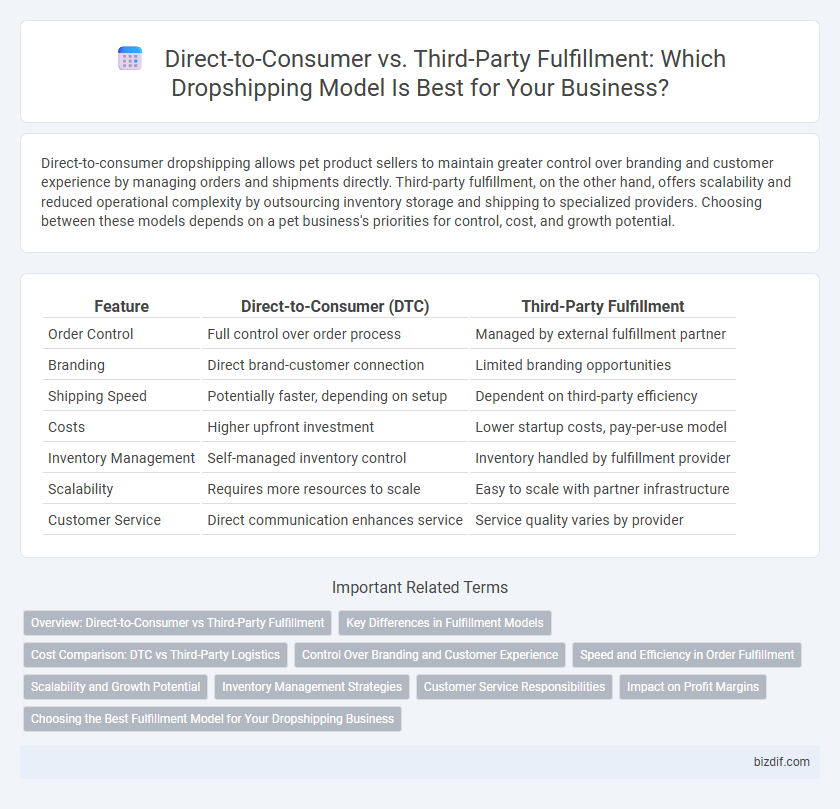Direct-to-consumer dropshipping allows pet product sellers to maintain greater control over branding and customer experience by managing orders and shipments directly. Third-party fulfillment, on the other hand, offers scalability and reduced operational complexity by outsourcing inventory storage and shipping to specialized providers. Choosing between these models depends on a pet business's priorities for control, cost, and growth potential.
Table of Comparison
| Feature | Direct-to-Consumer (DTC) | Third-Party Fulfillment |
|---|---|---|
| Order Control | Full control over order process | Managed by external fulfillment partner |
| Branding | Direct brand-customer connection | Limited branding opportunities |
| Shipping Speed | Potentially faster, depending on setup | Dependent on third-party efficiency |
| Costs | Higher upfront investment | Lower startup costs, pay-per-use model |
| Inventory Management | Self-managed inventory control | Inventory handled by fulfillment provider |
| Scalability | Requires more resources to scale | Easy to scale with partner infrastructure |
| Customer Service | Direct communication enhances service | Service quality varies by provider |
Overview: Direct-to-Consumer vs Third-Party Fulfillment
Direct-to-Consumer (DTC) fulfillment allows brands to control inventory, shipping, and customer experience by handling orders in-house, ensuring faster delivery and personalized service. Third-Party Fulfillment (3PF) leverages external logistics providers to manage storage, packing, and shipping, reducing overhead costs and scaling capabilities for dropshipping businesses. Choosing between DTC and 3PF depends on factors like order volume, budget, and the desired level of control over the supply chain.
Key Differences in Fulfillment Models
Direct-to-consumer fulfillment involves brands managing inventory and shipping directly to customers, offering greater control over product quality and customer experience. Third-party fulfillment outsources storage, packing, and shipping to specialized logistics providers, enabling scalable operations without the need for physical infrastructure. Key differences include control over inventory management, speed of delivery, and costs, with direct fulfillment often providing personalized service while third-party fulfillment excels in efficiency and scalability.
Cost Comparison: DTC vs Third-Party Logistics
Direct-to-Consumer (DTC) fulfillment typically incurs lower per-order costs by eliminating intermediaries, reducing overhead through direct control over inventory and shipping. Third-Party Logistics (3PL) providers charge fees for warehousing, packaging, and shipping services, which can increase overall costs but offer scalability and reduced operational complexity. Evaluating monthly order volume and storage needs is crucial for determining cost-effectiveness between DTC and 3PL solutions in dropshipping models.
Control Over Branding and Customer Experience
Direct-to-consumer (DTC) dropshipping grants sellers full control over branding, enabling customized packaging, personalized marketing, and consistent customer interactions that build brand loyalty. Third-party fulfillment services often limit brand customization options, resulting in generic packaging and less cohesive customer experiences that can dilute brand identity. Maintaining control over customer touchpoints through DTC strategies directly impacts customer satisfaction and repeat purchase rates.
Speed and Efficiency in Order Fulfillment
Direct-to-consumer dropshipping accelerates order fulfillment by eliminating intermediaries, enabling faster processing and shipping directly from suppliers to customers. Third-party fulfillment centers often streamline operations with advanced logistics networks, offering scalability but sometimes at the expense of longer delivery times. Prioritizing speed and efficiency in dropshipping hinges on choosing fulfillment methods that align with product demand, inventory control, and customer expectations.
Scalability and Growth Potential
Direct-to-consumer dropshipping offers greater scalability through direct control over branding, customer experience, and data analysis, enabling targeted marketing strategies that drive sustainable growth. Third-party fulfillment provides quicker market entry and reduced operational complexities but may limit scalability due to reliance on external logistics, impacting brand differentiation and customer retention. Evaluating growth potential requires balancing control over supply chain processes with the ability to rapidly expand through outsourced fulfillment networks.
Inventory Management Strategies
Direct-to-consumer dropshipping allows sellers full control over inventory management, enabling real-time stock updates and customized product selection to meet market demands efficiently. Third-party fulfillment relies on external warehouses and automated inventory systems, which can reduce overhead but may introduce challenges in stock visibility and restocking speed. Effective inventory management in both models requires integrating inventory tracking tools to minimize stockouts and optimize order processing times.
Customer Service Responsibilities
Direct-to-consumer dropshipping enables sellers to maintain full control over customer service, allowing personalized responses and tailored problem resolution that enhance customer satisfaction. Third-party fulfillment delegates customer service responsibilities to external partners, which can streamline operations but may result in less direct communication and slower issue resolution. Prioritizing direct engagement in customer service often leads to stronger brand loyalty and quicker feedback loops for product and service improvement.
Impact on Profit Margins
Direct-to-Consumer (DTC) dropshipping typically yields higher profit margins by eliminating intermediaries, allowing sellers to retain full retail markup. Third-party fulfillment incurs additional fees for warehousing and logistics, which directly reduce overall profitability. Efficient inventory management and cost negotiation with suppliers are crucial to maximizing margins in both fulfillment models.
Choosing the Best Fulfillment Model for Your Dropshipping Business
Choosing the best fulfillment model for your dropshipping business hinges on factors like control, cost, and scalability. Direct-to-consumer fulfillment offers greater brand control and personalized customer experiences but requires managing inventory and shipping logistics. Third-party fulfillment reduces operational burden by outsourcing warehousing and shipping to specialized providers, enabling faster scaling and broader product offerings with lower upfront investment.
Direct-to-Consumer vs Third-Party Fulfillment Infographic

 bizdif.com
bizdif.com